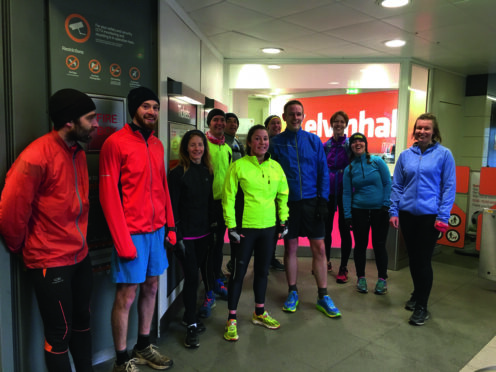
Glasgow’s historic underground transport system, the Subway, is the focus for a fun-running activity. Instead of travelling the 6.2-mile circuit by train, which takes around 24 minutes, runners aim to reach all 15 stations.
The idea for the Subrun was conceived by two members of Glasgow Triathlon Club (GTC), twins Iain and Andrew Todd.
Iain said: “I’d heard of the Tube Challenge, where people run between the London Underground stations, and I thought it would work well in Glasgow.
“The Subway is smaller than the Tube so it means the run is achievable for more people.”
It is a cool but dry Saturday morning when I meet friends in the Woodside area of Glasgow for the inaugural GTC Subrun. Starting outside St George’s Cross station, we run half a mile east at a chatty pace to Cowcaddens, before turning south to busier city centre streets.
The group strings out to weave around weekend shoppers as we reach Buchanan Street and St Enoch.
Turning south towards the Clyde, we run on a wide pavement across Glasgow Bridge, also known as Jamaica Bridge. The seven-arch structure was completed in 1772 and today it’s B listed.
There are seven Subway stations on Glasgow’s Southside and we reach Bridge Street first before running in a shallow arc westwards to West Street, Shields Road, Kinning Park, Cessnock, Ibrox and Govan.
Much of this area was formerly Govan Burgh and a centre of industry in the 18th and 19th Centuries, first for textiles and coal mining and then shipbuilding.
Our group’s pace continues to be relaxed and Iain and Andrew keep us on track with a route they have uploaded to GPS watches.
Every so often, we stop to take a closer look an interesting building or statue, or to view one of the city’s many stunning murals.
We complete the Subway circuit and return to the north of the city via the Clyde Tunnel. Two parallel vehicle tunnels of 2,500ft in length have connected Govan to Whiteinch since the ’60s.
There are two smaller pedestrian tunnels, too, and it’s an eerily silent experience to run beneath the city.
Coming into the daylight, we head east towards Partick Subway and then to Kelvinhall, Hillhead and Kelvinbridge.
Our tour finishes back at St George’s Cross, where Iain tells us we’ve run 11 miles.
If you are looking for a unique city sight-seeing tour, the Subrun is a great idea.
What Is Glasgow’s Subway?
The Subway is also known as the Clockwork Orange and was built in the late 1800s to serve the north and south of Glasgow’s city centre. The trains run clockwise on the Outer Circle and anti-clockwise on the Inner Circle and twice head beneath the River Clyde.

Enjoy the convenience of having The Sunday Post delivered as a digital ePaper straight to your smartphone, tablet or computer.
Subscribe for only £5.49 a month and enjoy all the benefits of the printed paper as a digital replica.
Subscribe